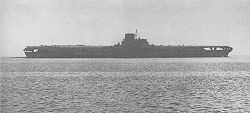Shinano (ship, 1944)
|
The Shinano on November 11, 1944
|
||||||||||||||||||
|
||||||||||||||||||
|
||||||||||||||||||
|
||||||||||||||||||
|
||||||||||||||||||
|
||||||||||||||||||
The Shinano ( Japanese 信 濃 ), originally started in 1940 as the third Japanese battleship of the Yamato class , was completed as an aircraft carrier in 1944 . It was named after the historic Shinano Province . As early as November 1944 - before it was first used - the ship was torpedoed and sunk by a US submarine on a transfer trip off the Japanese coast . The Shinano was by far the largest completed aircraft carrier of World War II .
history
Construction and completion
On May 4, 1940, according to the plans of the Imperial Japanese Navy, the keel of the Shinano was laid at the Yokosuka naval shipyard . The construction work proceeded quickly at first, but under the impression of the successes of the aircraft carriers and the increasingly insignificant role of the battleships, the further construction was stopped at the end of 1941. Since the hull of the Shinano was largely completed, it was decided not to demolish the material that had already been built, as was the case with the fourth ship of the Yamato class called the Kii, which had not yet progressed so far .
After the loss of four large carriers in the Battle of Midway in June 1942, it was decided to complete the Shinano as an aircraft carrier. The fact that the design was originally intended as a battleship turned out to be problematic. The heavily armored fuselage with few open spaces offered little room for the accommodation of aircraft. The final design for the further construction of the Shinano had to be a compromise solution. Because of the size of the ship and the storage space it provided for fuel and ammunition, the carrier was supposed to serve as a kind of mother ship for other full-fledged aircraft carriers, so the Shinano was supposed to support their operations as a reserve store and emergency landing site. Your own air group should be used primarily for self-protection.
How little the Japanese shipbuilding industry was converted to the increased demands of war production until 1944, shows the fact that the Shinano from continued construction despite starting from mid-1942 until October 8, 1944 stack could be left. On November 19, 1944, the ship was put into service under the command of Captain Abe in Yokosuka - despite outstanding work. It was provided with the camouflage paint used for the Imperial Japanese Navy at the end of the war. Its sides were dark green / light yellow green, with the darker surface being intended to simulate the outline of a merchant ship. The deck, however, was not camouflaged because of the sawdust-cement covering that could not be colored.
The downfall
In order to avoid the increasingly dangerous air strikes by the United States in Yokosuka , the Shinano was to be relocated to an equipment quay in Kure with an emergency crew made up of seafarers and shipyard workers who were not yet sufficiently familiar with the ship . Escorted by three destroyers , the huge aircraft carrier was sighted and attacked by the American submarine Archerfish on November 29, 1944 about 300 km southeast of Cape Muroto on the south coast of Japan . After four torpedo hits, the inexperienced crew had no way of preventing the ship's sinking due to the lack of anti-leak devices. Although the commander tried to level the list of the carrier by counter-flooding, the ship was stopped after its boiler failed and finally capsized seven hours after the torpedo hits. Of the 2215 crew members on board, 1435 were killed; among them the commander Toshio Abe and several pilots of a Kamikaze squadron who had been transported on the Shinano in their Ōka aircraft .
The Shinano is still the largest warship sunk by a submarine.
wreck
The wreck of the Shinano is believed to be near the last known position at 33 ° 7 ′ N , 137 ° 4 ′ E in the northern foothills of the Ryūkyū Trench .
See also
Web links
Side elevation and top view on globalsecurity.org (English)
Footnotes
- ^ A b Anthony P. Tully: IJN Shinano: Tabular Record of Movement. In: combinedfleet.com. Imperial Japanese Navy Page, 2001, accessed May 30, 2016 .
